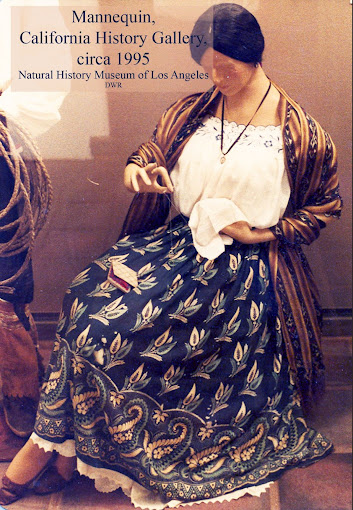I've examined two printed woolen petticoats at the Natural History Museum of Los Angeles. Both belonged to the Coronel Family, though I don't remember ever seeing in their records where and when they acquired them. Nevertheless, I believe they must have come from Mexico, either as souvenirs of a visit, imports, or as fabric. Petticoats are one of the few "readymade" garments available to women in this era because the waist, at least, was adjustable.
Though I did some color correction to my old photo, the actual petticoat has brighter colors, closer to what is shown in the Index of American Design gouache paintings made in the 1930s.
There
is a second woolen petticoat in the Coronel collection, red wool with a
white pattern, green top band and hem binding, with gilt brass sequins.
Though called a "child's skirt" it fit a full size mannequin, as shown in the museum's 1964 catalog.
Patterned petticoats of this style appear to have been associated at first with the "china poblana" fashion, the somewhat disreputable style created by young, free spirited urban women in Mexico who took their lower class clothing and decorated it - a kind of street fashion of the time.
The
fabric of these petticoats was, as I mentioned above, wool. It is
rather lightweight, and patterned with what appears to be resists and
block printing. From the available images, this type of fabric may not have
existed much earlier than the 1850s, though the basic technique of
patterning woolen fabrics with resists and block printing was much
older.
A note to American historical reenactors and interpreters: the Chinas Poblanas were a
Mexican phenomenon, and not a term or style used in the "Spanish Borderlands"* until after the Mexican-American War.
Photograph from the Grupo Presidente website: https://grupopresidente.com.mx/
In time, of course, the China Poblana style and spirit became emblematic of Mexican national pride.
*The Spanish Borderlands is a convenient term used to describe what are today's American Southwest from Texas to Arizona, southern Colorado, and both Baja and Alta California.










No comments:
Post a Comment